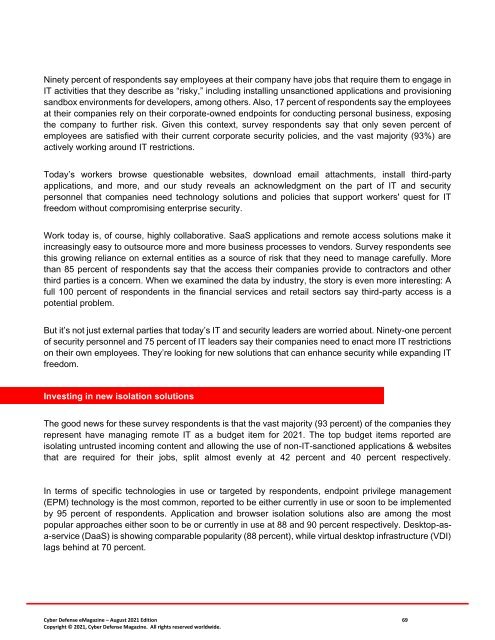Cyber Defense eMagazine August Edition for 2021
Cyber Defense eMagazine August Edition for 2021 #CDM #CYBERDEFENSEMAG @CyberDefenseMag by @Miliefsky a world-renowned cyber security expert and the Publisher of Cyber Defense Magazine as part of the Cyber Defense Media Group as well as Yan Ross, US Editor-in-Chief, Pieruligi Paganini, Co-founder & International Editor-in-Chief, Stevin Miliefsky, President and many more writers, partners and supporters who make this an awesome publication! Thank you all and to our readers! OSINT ROCKS! #CDM #CDMG #OSINT #CYBERSECURITY #INFOSEC #BEST #PRACTICES #TIPS #TECHNIQUES
Cyber Defense eMagazine August Edition for 2021 #CDM #CYBERDEFENSEMAG @CyberDefenseMag by @Miliefsky a world-renowned cyber security expert and the Publisher of Cyber Defense Magazine as part of the Cyber Defense Media Group as well as Yan Ross, US Editor-in-Chief, Pieruligi Paganini, Co-founder & International Editor-in-Chief, Stevin Miliefsky, President and many more writers, partners and supporters who make this an awesome publication! Thank you all and to our readers! OSINT ROCKS! #CDM #CDMG #OSINT #CYBERSECURITY #INFOSEC #BEST #PRACTICES #TIPS #TECHNIQUES
You also want an ePaper? Increase the reach of your titles
YUMPU automatically turns print PDFs into web optimized ePapers that Google loves.
Ninety percent of respondents say employees at their company have jobs that require them to engage in<br />
IT activities that they describe as “risky,” including installing unsanctioned applications and provisioning<br />
sandbox environments <strong>for</strong> developers, among others. Also, 17 percent of respondents say the employees<br />
at their companies rely on their corporate-owned endpoints <strong>for</strong> conducting personal business, exposing<br />
the company to further risk. Given this context, survey respondents say that only seven percent of<br />
employees are satisfied with their current corporate security policies, and the vast majority (93%) are<br />
actively working around IT restrictions.<br />
Today’s workers browse questionable websites, download email attachments, install third-party<br />
applications, and more, and our study reveals an acknowledgment on the part of IT and security<br />
personnel that companies need technology solutions and policies that support workers' quest <strong>for</strong> IT<br />
freedom without compromising enterprise security.<br />
Work today is, of course, highly collaborative. SaaS applications and remote access solutions make it<br />
increasingly easy to outsource more and more business processes to vendors. Survey respondents see<br />
this growing reliance on external entities as a source of risk that they need to manage carefully. More<br />
than 85 percent of respondents say that the access their companies provide to contractors and other<br />
third parties is a concern. When we examined the data by industry, the story is even more interesting: A<br />
full 100 percent of respondents in the financial services and retail sectors say third-party access is a<br />
potential problem.<br />
But it’s not just external parties that today’s IT and security leaders are worried about. Ninety-one percent<br />
of security personnel and 75 percent of IT leaders say their companies need to enact more IT restrictions<br />
on their own employees. They’re looking <strong>for</strong> new solutions that can enhance security while expanding IT<br />
freedom.<br />
Investing in new isolation solutions<br />
The good news <strong>for</strong> these survey respondents is that the vast majority (93 percent) of the companies they<br />
represent have managing remote IT as a budget item <strong>for</strong> <strong>2021</strong>. The top budget items reported are<br />
isolating untrusted incoming content and allowing the use of non-IT-sanctioned applications & websites<br />
that are required <strong>for</strong> their jobs, split almost evenly at 42 percent and 40 percent respectively.<br />
In terms of specific technologies in use or targeted by respondents, endpoint privilege management<br />
(EPM) technology is the most common, reported to be either currently in use or soon to be implemented<br />
by 95 percent of respondents. Application and browser isolation solutions also are among the most<br />
popular approaches either soon to be or currently in use at 88 and 90 percent respectively. Desktop-asa-service<br />
(DaaS) is showing comparable popularity (88 percent), while virtual desktop infrastructure (VDI)<br />
lags behind at 70 percent.<br />
<strong>Cyber</strong> <strong>Defense</strong> <strong>eMagazine</strong> – <strong>August</strong> <strong>2021</strong> <strong>Edition</strong> 69<br />
Copyright © <strong>2021</strong>, <strong>Cyber</strong> <strong>Defense</strong> Magazine. All rights reserved worldwide.


















